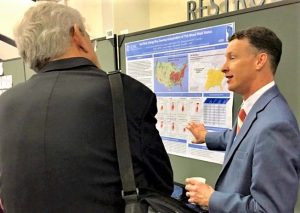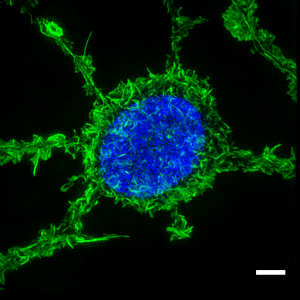Basic and Translational Research
The Thurston Arthritis Research Center’s Basic and Translational Research program is investigating the underlying mechanisms that promote the development and progression of conditions relevant to rheumatology, allergy and immunology.
Basic and Translational Research — Faculty and Primary Focus:

Richard F. Loeser, Jr., MD (Director):
Joseph P. Archie, Jr., Eminent Professor of Medicine
Mechanisms responsible for joint tissue destruction in osteoarthritis, including the role of aging and oxidative stress and cell signaling stimulated by matrix fragments acting through integrin receptors.
-More information about about Dr. Loeser’s lab.
Scott Commins, MD, PhD:
Associate Professor of Medicine
Food allergy to red meat; including why allergic reactions are delayed 3-6 hours after eating, and the role that tick bites may have in initiating allergic response to the carbohydrate galactose-alpha-1,3-galactose (“alpha-gal”).
-More information about about Dr. Commins’ lab.

Brian Diekman, PhD:
Assistant Professor of Biomedical Engineering
The mechanisms by which aging and genetics contribute to osteoarthritis risk and how regenerative medicine technologies may lead to novel treatment strategies.
-More information about Dr. Diekman’s lab.
Onyinye Iweala, MD, PhD:
Assistant Professor of Medicine
Glycolipids, unconventional T cells, and their role in alpha-gal red meat allergy and epigenetic regulation of allergic, anti-parasitic, and regulatory immune responses.

-More information about Dr. Iweala’s lab.
Lara Longobardi, PhD:
Assistant Professor of Medicine
The mechanisms leading to osteoarthritis development, especially the role of chemokines in cartilage and bone generation after injury, and how they affect pain response.
-More information about Dr. Longobardi’s lab.
Doug Phanstiel, PhD:
Assistant Professor of Cell Biology and Physiology
The manner in which DNA loops regulate monocyte differentiation, both in healthy cells and in the context of rheumatoid arthritis.
-More information about Dr. Phanstiel’s lab.
Erin Steinbach, MD, PhD:
Assistant Professor of Medicine
Defining the regulatory landscape (epigenetics) of intestinal epithelial cells (IECs) as a mechanism of barrier dysfunction during peanut allergy; identifying biomarkers and IEC molecular signatures that predict clinical outcomes in peanut allergy.
-More Information about Dr. Steinbach’s lab.
Additional Research Faculty and Primary Focus:
Dan Bracey, MD, PhD: (Orthopedics)
Hip and knee arthroplasty, tissue biorepository, tissue engineering, bone regeneration, xenotransplantation
Matthew Fisher, PhD (Biomedical Engineering)
Biomechanics, growth, tissue engineering, large animal models.
Duncan Lascelles, PhD (Translational Pain Research)
Neurobiology, pharmacology, regenerative medicine
Janet Rubin, MD (Endocrinology and Metabolism)
Metabolic bone diseases
Lauren Schnabel, PhD, DVM: (Comparative Medicine)
Regenerative and biologic therapies, musculoskeletal injury, orthopedic biofilm infection, large animal models.
Maya Styner, MD (Endocrinology and Metabolism)
Metabolic bone disease, osteoporosis, lipodystrophies, and general endocrinology
Jenny Ting, PhD (Genetics)
Innate immunity, dendritic cell function, cell death, autophagy, signal transduction
Barb Vilen, PhD (Microbiology and Immunology)
Mechanisms of tolerance in systemic lupus erythematosus
Morika Williams, PhD, DVM (Comparative Medicine)
Mechanisms by which early life injury and pain contribute to osteoarthritis-associated pain, especially role of neuroimmune cell responses and how they affect pain